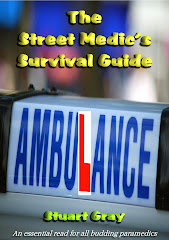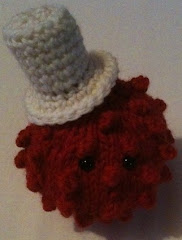Day shift: Nine calls; all by ambulance.
Stats: 6 Falls with head injuries (1 with broken nose); 1 Knee injury; 1 Hyperventilation.
This ambulance shift is with Emma and she is a good friend of mine from a few years back. Our first call is to a 45 year-old male who’s lying in the street with an ‘upset stomach’ – this was designated a Red3 and that was the description given. I get upset stomachs but I don’t believe it’s an emergency. When I arrive I realise why it’s been categorised that way; the call has come from the police.
I also know the man on the ground – he is a gel-drinking alcoholic and he can be very aggressive – not violent, just angry. He also smells very, very bad and often defecates into his trousers, leaving the mess there for days at a time. This was not the best breakfast start to the day for us.
Predictably he bemoaned his life and predictably he began to raise his voice as he became more and more frustrated with my crew mate’s questions. Emma has the patience of a saint; I don’t – so he was told to calm down and stop raising his voice.
‘I want to die’, he kept repeating, ever louder. I feel the same - the smell is overpowering at times.
When we get to hospital (police officer on board just in case) he is put into a secure room but he’s not happy at all. The last time I see him before I leave is on the CCTV monitor – he’s curled up on the sofa with a blanket around him - complaining about everything and everyone.
Our next call, soon after, is for another gel-drinker and the evidence is still on the ground next to him. A small bottle of orange, mixed with alcohol-gel is testament to his current condition. The 70 year-old man was seen to collapse and land on his head, opening it up at the back. Two helpful ladies from a nearby coffee shop tended to him until we arrived. He smelled the same as our previous patient. Perhaps the gel-alcohol gets into the urine and gives it that ‘special’ aroma. He hadn’t been incontinent, however, so it was a less stressful dilemma for the olfactory nerves.
He was semi-conscious and hypothermic (32c), so a couple of blankets, some warmed IV fluids (we don’t have a fluid warming system, so I use the ambulance heater) and a blue call to hospital were in order. By the time he reached Resus, he was a little more alert.
Then we went south to the aid of a 46 year-old man who fell in the street as a result of a ‘dodgy knee’ he’d twisted a few days before but ignored. One look at it confirmed that it was sprained at best – fractured or dislocated at worst. His leg was rotated at the knee so that it deviated from its natural line – it was obvious when he lay on the trolley bed. No wonder he’d been unable to walk on it.
We splinted it and gave him pain relief – entonox does the trick for this sort of thing. This time he would have to go and get it sorted.
We were sent on Active Area Cover (AAC)…or stand-by as we used to call it and, as if to prove a point, the next call came from just down the road. A 64 year-old female had fallen on a bus and had a head injury. AAC is fairly new and the idea, combined with call-connect, in which an ambulance (or solo) is despatched as soon as the address of the call is confirmed, is to speed up our response times to your emergency, perhaps saving one or two minutes. That’s all very nice and I appreciate that we need to be with you as soon as possible but a system based on prediction and human folly is bound to fail sooner or later. For the time being it seems to be doing its job. Either that or we are being sent to a specific location and calls are being setup for us. That’s too far-fetched and very cynical of me, I know.
Anyway, despite this wondrous technological advance, they still managed to get the wrong location and wrong bus number, so we wasted a minute trying to locate our patient in the heavy rush-hour traffic of Oxford Street. See? You just can’t knock human intervention.
The woman was fine; she’d fallen onto the back of her head when the bus braked hard to avoid hitting two kids as they darted across its path. Fair enough, the driver had to avoid the collision and maybe she should have been seated, as per the instructions for every passenger BUT I really wish he hadn’t said that he ‘broke’ hard to avoid hitting them. There was worse news for my ears, however, when the police officer attending the scene said exactly the same thing. It irritated me as much as seeing an apostrophe hanging over an S in a plural. Scottish and fussy about my English, that’s me.
We went back to Oxford Street later on to tend to an 84 year-old woman who’d tripped on a defective paving slab and fallen onto her nose. She had two hands full of shopping (and they say there’s a recession), so she was unable to stop herself landing full-force on that facial organ. ‘I heard it crack’ she said with a soft, smiley Irish tone.
The poor woman’s septum was deviated so far to the right that she looked like a prize fighter with a story to tell.
The strangest call of the day next and a FRU was on scene with an 81 year-old lady who woke up in the morning, had a bath, brushed her hair and felt something wet on her hands. She looked down and realised she was bleeding. The FRU pilot examined her and found a huge open bump at the back of her head. It looked like she’d been mugged with a cricket bat, yet she had no pain and no idea how this had occurred.
She had a GCS of 15 and all her obs, apart from her blood sugar, which was high, were normal. She wasn’t diabetic, so her BM was a little suspicious and we searched our minds for a connection. She hadn’t fallen, hadn’t been hit BUT she was taking Warfarin and that seemed to lead me to a reasonable possibility, although I needed a mechanism, like a fall or knock to the head to support it.
Obviously she was bleeding heavily from the wound and so it was dressed tightly and she was taken to hospital where no doubt higher paid people with more time on their hands would work it all out.
If you see an ambulance parked up with blue lights flashing and you are a multi-drop driver, keen to make that urgent delivery, please don’t park so close to the back of the ambulance that the crew can’t lower the ramp to take a non-walking patient on board. If the lights are flashing we are definitely working – not queuing for a coffee and cake at the local café.
A florist decided he’d unload what must have been dreadfully important plants directly behind our vehicle. He was so close that our ramp would have settled on his bonnet, had I been annoyed enough to go ahead and lower it anyway. Our patient, a lovely 85 year-old lady who’d fallen on the escalator at a John Lewis store, was being wheeled out with a head injury. To save us lifting her up the steps of the ambulance, my plan was to put the chair on the lift and gently (safely) raise her into the vehicle that way. She was unsteady on her feet, so it was the kindest thing to do. Mr Florist had other ideas and not even the sight of her having to be walked on wobbly legs made him feel guilty enough. Thank goodness we weren’t resuscitating someone.
We took the lady to hospital and she was directed to the waiting room because there were no beds. We wheeled her next to our last head injury patient, the Irish lady and they both got chatting. I suggested a game of cards.
A quick and easy hyperventilation next. A 65 year-old was having a panic attack at an art gallery and we spent no more than a few minutes calming her down after the MRU bod had started the ball rolling.
The last job came from just around the corner as we waited at hospital. A 12 year-old boy had fallen on his head. He was described as ‘dizzy’. That was under-selling it; he’d been aloft on his friends shoulders next to a busy road – they were larking about and he took a tumble onto the pavement. His tooth pierced his bottom lip, leaving a ragged tear and hole in it as he met the concrete with his face. He hadn’t been knocked out and his mates (there were a lot of them) could have walked him to the hospital but these days, everything is an emergency, right?
Be safe.
Subscribe to:
Post Comments (Atom)















2 comments:
Ah the lovely AAC - on our desk we give each other a chocolate bar if we manage a "psychic AAC" - the AAC and the call have to be in exactly the same road!! Pat on the back for us, up go the stats!! How historical data can help us I don't know!! Surely it would be very unlikely for one road junction to repeatedly have heart attack patients year after year!! (Unless of course it was a junction with a nursing home but that's cheating!!)
I was reading about the gel drinkers and was wondering if you still get the methylated spirit drinkers? When I used to work at King's Reach Tower, I'd have to get past the rough sleepers at the Waterloo Bullring. Several of them used to pour methylated spirit through loaves of stale bread, add a splash of orange juice and then drink the resulting "cocktail".
I remember one was quite badly burned as he was smoking in between drinking mouthfuls of the stuff, and set himself alight.
I'm glad I don't live and work down there any more.
Post a Comment